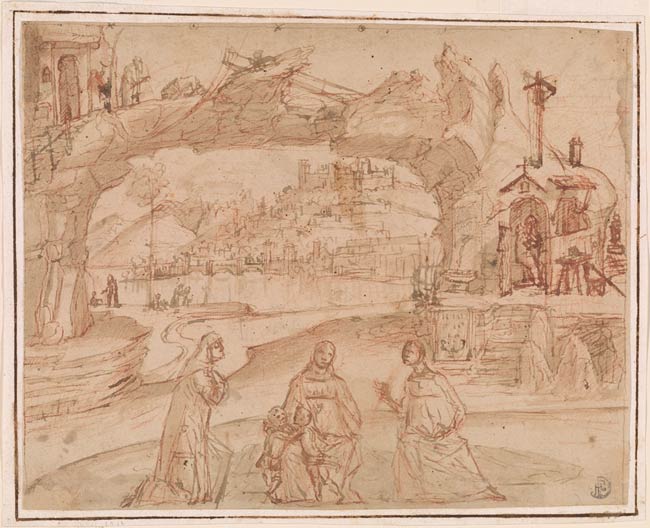
The present drawing is Carpaccio’s compositional study for his panel painting of about 1500–1510 depicting the Virgin and Child with Four Saints, formerly in the Musée des Beaux-Arts, Caen, and now in the Musée du Petit Palais, Avignon. Although the Virgin is flanked by only a pair of female saints in the Morgan drawing, the foreground group would be expanded in the painting to include the seated Virgin, the Christ Child, John the Baptist, the two adoring female saints—probably Elizabeth (the mother of St. John) wearing the wimple on the left, and Mary Magdalene, seated, with an open book on her lap, on the right—and two male saints, probably Zaccharias (the father of John the Baptist) on the left and Joseph on the right.
Despite the changes to the foreground, the complex, fantastic landscape background of the drawing was reproduced almost exactly in the painting. It provides the setting for three hermit saints—Augustine, Jerome, and one generally identified as Anthony Abbot— all of whom are described with Carpaccio’s typical anecdotal detail. Augustine is seen in the distance at center left standing by the shores of a lake and speaking to the small child who, according to legend, made him aware of the futility of attempting to understand the Holy Trinity. Jerome, recognizable from the accompanying lion, is at upper left on the rocky arch; Anthony Abbot, at right, is seated just inside a small hut surmounted by a cross. In the painting Anthony Abbot is accompanied by two monks, one kneeling before him in prayer and the other seated at work. In all likelihood a manifestation of the monastic rule of ora et labora (prayer and work), the monks may also illustrate a related episode in the Golden Legend that tells of the exemplary angel that twice appeared to Anthony, first as he was sitting at work and then as he rose to pray.1
Two further drawings related to the Avignon painting are known, one formerly in the Gathorne-Hardy collection and now in the National Gallery of Art, Washington,2 the other in the Uffizi, Florence.3 Both studies focus on the disposition of the foreground figures and, unlike the present one, do not include the entire scene.
Although Carpaccio has often been seen as a rather conventional painter, he can be considered—especially in his drawings—a forward-looking and experimental artist. The present drawing, for example, is one of the earliest in European art to integrate figures into a finished landscape, and in its combination of red chalk, pen, ink, and wash, it is an early example of a type of Venetian drawing that would continue to flourish through the eighteenth century.
—REP
Footnotes:
- Sgarbi 1994, 162.
- Inv. 1990.43.1. See Lauts 1962, no. 9, and Venice 2014–15, no. 8.
- Inv. 1692f. See Lauts 1962, 269, no. 16.
Late compositional study for Carpaccio's panel painting of ca. 1500-1512.
Among the foremost painters of fifteenth-century Venice, Carpaccio is notable for the elaborate urban or landscape settings of his compositions. In the foreground of this drawing, made in preparation for a painting now in the Musée du Petit Palais, Avignon, the Virgin Mary is sitting on the ground with the Christ child and John the Baptist. At her sides are two adoring female saints: Elizabeth, the mother of St. John, and Mary Magdalene, on the right with an open book on her lap. The somewhat bizarre landscape provides a setting for hermit saints on the rock arch and throughout the background. -- Exhibition Label, from "Drawn to Greatness: Master Drawings from the Thaw Collection"
Watermark: Circle with balance inside, surmounted by six-pointed star.
Dubini, Francesco, 1848-1932, former owner.
Rasini, Giovanni, 1892-1952, former owner.
Rasini, Cesare, 1920-1993, former owner.
Thaw, Eugene Victor, former owner.
Thaw, Clare, former owner.
Rhoda Eitel-Porter and and John Marciari, Italian Renaissance Drawings at the Morgan Library & Museum, New York, 2019, no. 57.
Selected references: Morassi 1937, 25; Tietze and Tietze- Conrat 1944, no. 624; Arslan 1952, 109; Laclotte 1956, 231n3; Fiocco 1958, 33; Lauts 1962, no. 35; Pignatti 1963, 51; Venice 1963, no. 16; Muraro 1966, 69, 109; Zampetti 1966, 76; Cancogni and Perocco 1967, under no. 22; Pignatti 1972, no. 24; Muraro 1977, 59-60; Sgarbi 1994, 162; White 1994, no. 34; London 1998a, no. 1; New York 2002-3, no. 1; New York 2006, no. 8; New York and Williamstown 2017-18, 39, and no. 34.
The Morgan Library & Museum, New York, NY, "Drawn to Greatness: Master Drawings from the Thaw Collection", 2017. Exh. cat., no. 34, repr.
The Thaw Collection : Master Drawings and Oil Sketches : Acquisitions since 1994. New York : Pierpont Morgan Library, 2002, no. 1, repr.
From Leonardo to Pollock: Master drawings from the Morgan Library. New York: Morgan Library, 2006, cat. no. 8, p. 20-21.

